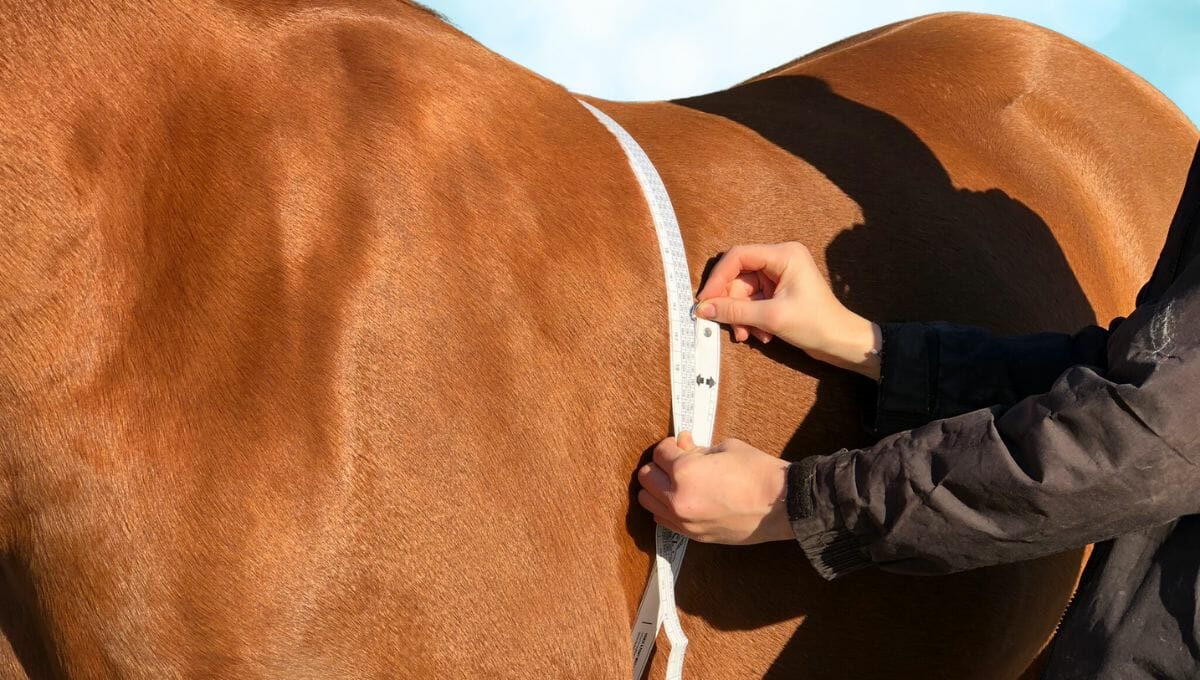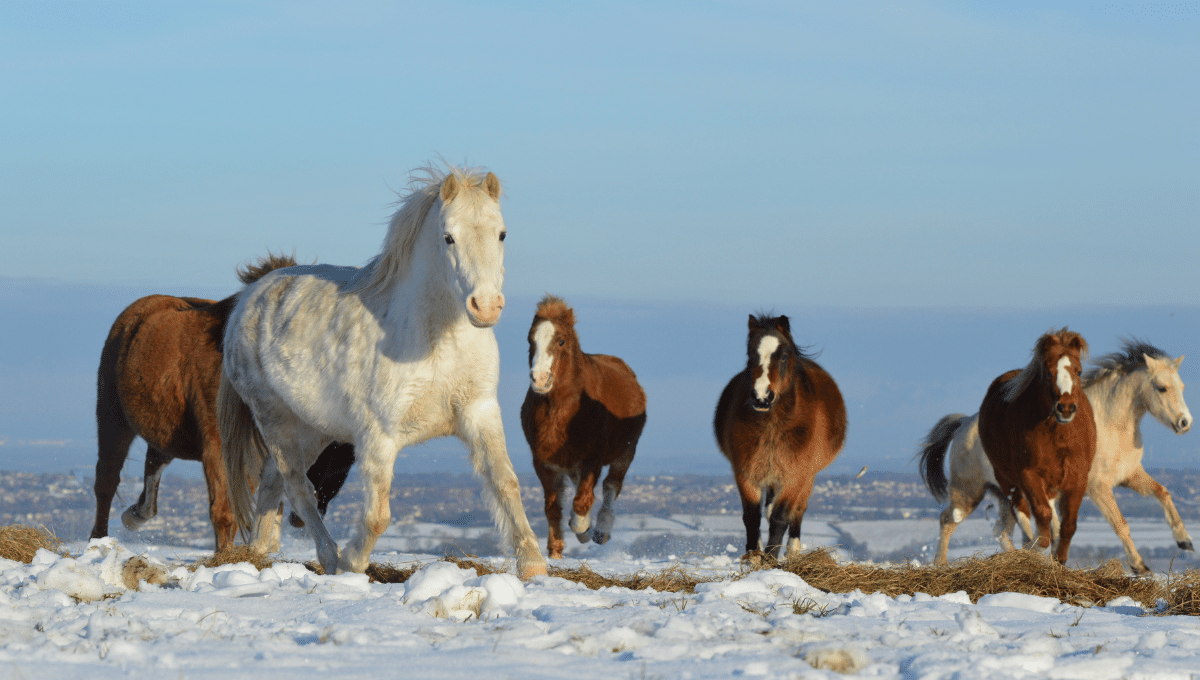How do you control horse weight so that your horse maintains a healthy body weight? Horse weight can increase at a fast rate, so owners rightly worry about weight gain.
This article will help you with the numbers aspect of the management and control of horse weight.
Recent research found that rates of obesity in the UK equine population are likely to be running at 30–50% and may even be as high as 70% in native pony breeds. Even in horses used for competition horse weight is often too high.
The questions you need to ask are: Do you need to stop or reduce horse bucket feed? Do you need to soak or restrict horse hay? Do you need to restrict grazing with a grazing muzzle or give your horse less time eating grass? What is the best way to manage horse weight so that you are in control and your horse stays healthy, safe and laminitis-free?
How can I tell if my horse is overweight?
The best way to tell if your horse is overweight is to use a body conditioning score (BSC). This is a way of estimating your horse’s body fat that is stored directly under the skin.
There are BCS scale rates which score horse weight from 1 to 9, with a score of 1 considered very thin and 9 considered very obese. A simpler way to BSC is a 5-point scoring system.
How to assess horse bodyweight
As horses gain weight, fat accumulates over the horse’s whole body and in these six areas:
- Over the tailhead
- Over the rump
- Along the withers
- Along the neck
- Over the ribs
- Behind the shoulder
By visually assessing and palpating these key areas, you can understand where your horse falls on the 9-point scoring system.
You can also weigh or accurately estimate your horse’s weight in one of three ways:
- Using an equine scale
- Using a horse weight tape
- Using a weight formula
Using a weight formula or horse weight tape are the easiest two ways to assess body weight as an equine scale is large and expensive to buy. Carrying out weight assessment every one to two weeks. Keep a record of the measurements and take a photograph of your horse from the side, stood square. This
will allow you to monitor your horse and check for weight gain or loss. We have a useful PDF here on assessing weight.
How much should a healthy horse weigh?
Horse weight is determined by height and genetics. Heavier-boned and muscled breeds will weigh more than breeds of the same height with lighter bone and less muscle.
For example, a Suffolk Punch may stand 16 hands high and weigh 800 kg at a healthy weight due to having thick bone and large muscle mass. On the other hand, a 16-hand Thoroughbred is likely to be at a healthy weight of 500 kg.
This article lists the likely horse weights of different breeds.

What do I need to understand about horse weight control?
The first thing is to realise that the most calories, and indeed the most nutritional value in the horse’s diet, come from the forage they eat. Forage is grass, hay or haylage and it is this that will contribute the most to horse weight maintenance, loss or gain.
Many horse articles call grass, hay or haylage, roughage. Roughage can be a misleading term for horse owners as it implies that this food provides just fibre rather than being the main source of calories, protein, vitamins and minerals in the horse’s daily diet.
When you start with the grass, hay or haylage a horse eats, it becomes easy to control horse weight and be in control of keeping your horse at the healthiest body weight. This is because forage should always be the greatest proportion of the diet.
What you need to have an idea of is how much hay and grass a horse is likely to eat and how many megajoules (MJ) a horse will consume that will affect horse weight. Megajoules are the unit used to calculate calories in the horse diet.
You also need to know if your horse is a healthy body weight. Find an article here to help further in estimating horse weight which will help you use a weight formula to assess horse body weight and determine if your horse needs to lose or gain weight.
How much hay will a horse eat each day?
From the data we hold at Forageplus, from thousands of scientific forage analyses, we know that hay is usually about 8.5 MJ per kilogram. However, hay calorie content can be higher or lower, so if you have a horse that is under or overweight, testing the nutritional value of the hay will be important.
A 500 kg horse is likely to consume 2% of its body weight in hay over a 24-hour period. This means it will consume around 10 kg of hay. This is based on the dry matter weight of the hay eaten.
Where you choose a hay and the nutritional data shows a range of energy figures, from low to high, then use the higher figure or ask the company for better data on the batch of forage you have bought. Managing weight effectively is about knowing the figures so the maths is accurate.
A high and low range may help the company but it won’t help you be accurate for horse weight loss or gain.
How many calories will come from the hay a horse eats each day?
Using 10 kg of hay fed per day (dry matter content) a 500kg horse will consume 85 MJ of calories in their diet from 10 kg of hay.
If this horse is in light work he/she will need 83.7 MJ per day for horse weight maintenance, meaning that the hay could be supplying too many calories for to maintain a healthy weight. If the horse is in no work then there will almost certainly be too many calories and weight gain will be the result.
This horse in moderate work needs 97.6 MJ per day for weight maintenance, meaning that extra calories in a bucket feed will need to be supplied in the daily diet.
Horse weight maintenance, loss or gain will depend upon the level of work a horse is in, as well as the MJ content of the hay. Here we have used an average MJ level, to help you understand the impact forage has on the calories in a horse’s diet, but some hays will be more than this and some hays less.
Although feeding adlib hay is popular for digestive health you can see that care needs to be taken that horses do not accumulate excess weight over time, especially if they are not in work.
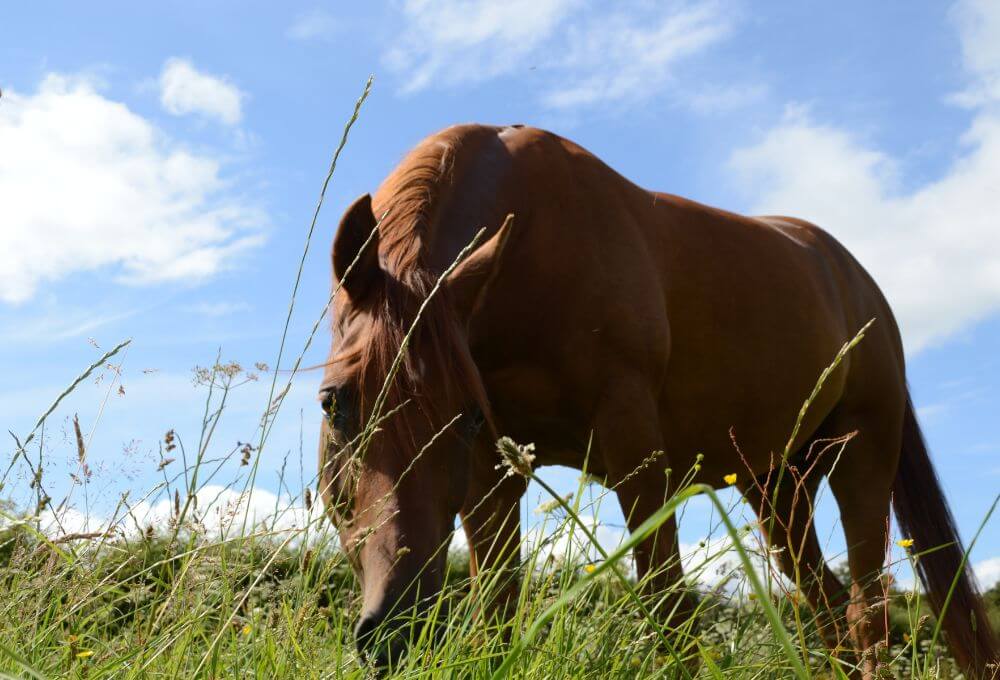
How much grass will a horse eat?
A 500 kg horse consuming 2% of its body weight in grass over a 24-hour period, in spring and early summer, will consume around 10 kg of grass.
This amount is based on the dry matter weight of the grass eaten. The actual weight of grass including the water content is likely to be higher than 40 kg per day. Spring and early summer grass is high in calories. Often at least 11 MJ per kilogram.
How many calories will come from the grass a horse eats each day?
A 500 kg horse will consume 110 MJ of calories in their diet from grass over a 24-hour period.
If this horse is in light work he/she will need 83.7 MJ per day for weight maintenance, meaning that the grass is likely to be supplying many more calories than is needed and so weight gain will be probable.
This horse in moderate work needs 97.6 MJ per day for weight maintenance so again weight gain is likely if the grazing is good and supplies too many calories, per day, to maintain a healthy horse weight.
Horse weight maintenance, loss or gain will depend upon the level of work a horse is in, as well as the MJ content of the grass. Here we have used an average MJ level for spring and summer grass but some grasses will be more than this and some grasses less. MJ level of grass depends on many different factors including, soil health, length and maturity of grass, species of grass, and grass plant health.
How many calories will come from the grass a horse eats in a four-hour period?
Many horses have access to grazing turnout just through the day or night. In order to understand how many calories this time will contribute, then the following is useful information to help manage horse weight.
If a 500 kg horse is eating pasture for four hours per day, it will eat around 3.69 kg of dry matter content of grass (this figure comes from research carried out by Paul Siciliano, North Carolina State University). This means that it is likely that 40.6 MJ will be coming from the grass.
Knowing this means you can subtract this amount from your horse’s usual weight of hay fed and calculate how many calories might come from a bucket feed which has a variety of proteins, is a good carrier for supplements, and provides slow-release, non-heating energy. You will now have the total calories as MJ per day.
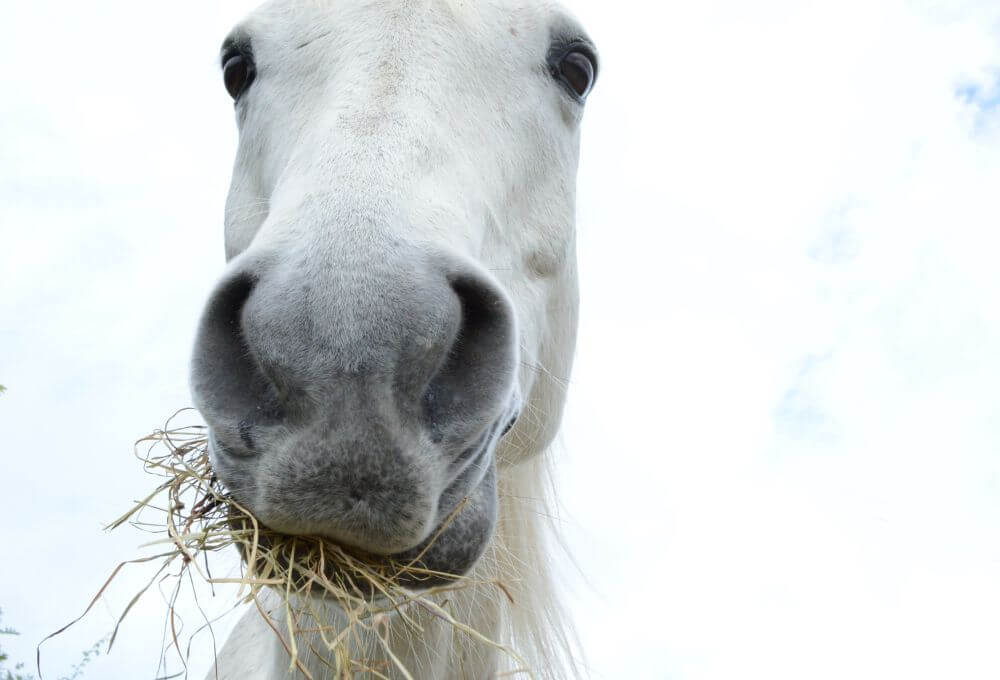
How do I know how much hay to feed when my horse also eats grass?
This requires you to use the above research data to estimate the amount of grass eaten and calculate the possible calories coming from this grass. Here we have used figures from four hours of spring and summer grazing to help you understand the impact even this short amount of time can have on horse weight
To work out how much hay to feed when your horse also grazes on grass for four hours, take the amount of grass eaten (3.69 kg) and subtract 3.69 kg from 10 kg of hay fed as dry matter.
This equals 6.31 kilograms of hay as dry matter, which will supply 53.63 MJ. We now have to work out what the weight of the hay you will feed to your horse with the water added in will be.
Hay runs at about 90% dry matter and 10% water. To work out the ‘as fed rate’ with the water, divide 6.31 by 0.9 to get the ‘as fed’ weight to feed as 7 kg.
Here is where it gets interesting because if you feed the 7 kg of hay and turn out for 4 hours this 500 kg horse will consume 94.23 MJ per day.
The amount needed for moderate work to maintain body weight is 97.6 MJ. What this means is that if you have a horse at maintenance or in light work then you will need to reduce the amount of hay you are feeding so you do not contribute too many calories and struggle to control horse weight.
Now you might be starting to have more understanding about how controlling both the amount of grass and the amount of hay a horse eats is very important for controlling the number of calories which might affect weight gain or loss.
When is the best time to give access to grass for horse weight management?
Spring and early summer grass will be high in calories. Some horses are just best off the grass for this period of time which is what we call the rocket fuel months. However, from an enrichment point of view, the urge to graze and search for forage is so strong in horses that confining them can cause behavioural problems.
The best time to graze a sensitive or overweight horse, on spring and summer grass, is after 3 am but before 10 am. Grasses create sugars in the leaf through photosynthesis generated by sun exposure throughout the day. Then the grass uses this energy, through the night, to grow or to store in the roots and lower leaf.
It takes several hours after sunset for sugar and starch levels to drop, so grazing in the early hours of the morning will be the time when the grass is lowest in carbohydrates.
If it is a cloudy spring or summer day then horses may be able to be left out a little longer in the morning, but as high carbohydrate fuels weight gain it is wise to restrict grazing and also to time grazing for when the levels are lowest in this feed source.
Winter grass will be different. When temperatures drop below freezing, sugar levels are highest in the grass in the early morning. At low temperatures, which cause frost, the plants’ growth rate slows, which means stored sugars aren’t used up.

Can I use a grazing muzzle to control horse weight?
Grazing muzzles can be a very useful tool to help limit grass intake but still allow grazing behaviour and turn out for mental health and exercise. Studies have shown that some muzzles can limit intake by as much as 80% but it depends on the horse as to how well accepted they are.
Some horses will become very frustrated by wearing muzzles. Other horses will accept the muzzle, but if the length of grass is short they may get very little fibre in their diet. Poor fibre content in the diet can result in digestive issues such as colic and gastric ulcers.
We are not big fans of grazing muzzles at Forageplus. This is largely due to the fact that you cannot measure how much grass a horse is, or is not getting, they can rub and cause facial sores, and if the horse gets the muzzle off it can gorge on grass which could trigger a laminitis attack.
We feel if it works for you and your horse that is fine but that the wearing of any muzzle should only be for a maximum of four hours. This will avoid digestive issues.
Where is the most sugar in the grass plant?
Another important consideration is that most of the sugar in grass tends to be in the bottom 7 to 10 centimetres of the plant. It has been suggested that a very short, overgrazed pasture is safe because there’s “nothing out there” and the horse gets less volume of food per mouthful. But short overgrazed pastures present many risks:
- The grass contains very little fibre – fibre is crucial for digestive health and ‘diluting’ carbohydrate intake so it is not concentrated.
- The grass will be stressed – stressed grass will contain a high sugar content.
- Only the lower centimetres of the plant are available to eat which is where the highest sugar and starch level is in the plant.
- Each mouthful is relatively high in carbohydrates because sugar/starch is stored at the base of the plant. So each mouthful has a high sugar / low fibre ratio.
- On short-cropped grass, horses will not be getting the fibre content that is needed to keep their digestive system healthy.
- The soil will be compacted leading to the grass having a shallower root system. Shallow root systems cause the plant to rely more on photosynthesis to survive so higher levels of carbohydrates will be created to substitute for the weak roots.
- The grass is likely to be high in iron and manganese levels which will block the uptake of copper and zinc which is crucial for metabolic health.
- Short grass will be ‘dirty grass’ which exposes the grazing horse to the top surface of the soil. This will raise heavy metal contamination in the diet and grazing in a space where undesirable bacteria may be proliferating. A healthy digestive microbiome has been linked to the ability to maintain a healthy weight.
- Short grass grazed on sandy soils may lead to horses ingesting sand.
- Where grass is grazed short droppings are usually removed daily. This lowers the organic matter in the soil and creates poor microbial activity between the plant and the soil micro-organisms. Poor microbial activity leads to higher carbohydrate content in the grass.
As such, proper pasture management is very important to keep grasses from becoming stressed. This means horse owners need to properly fertilize horse grazing pastures.
It’s better for the plant and safer for the horse to stop grazing when the pasture has only about 7 to 10 cm of height left. This not only reduces sugar intake by your horse but also leaves some leaf for the plant so that it can regrow without having to dip into root stores too heavily.
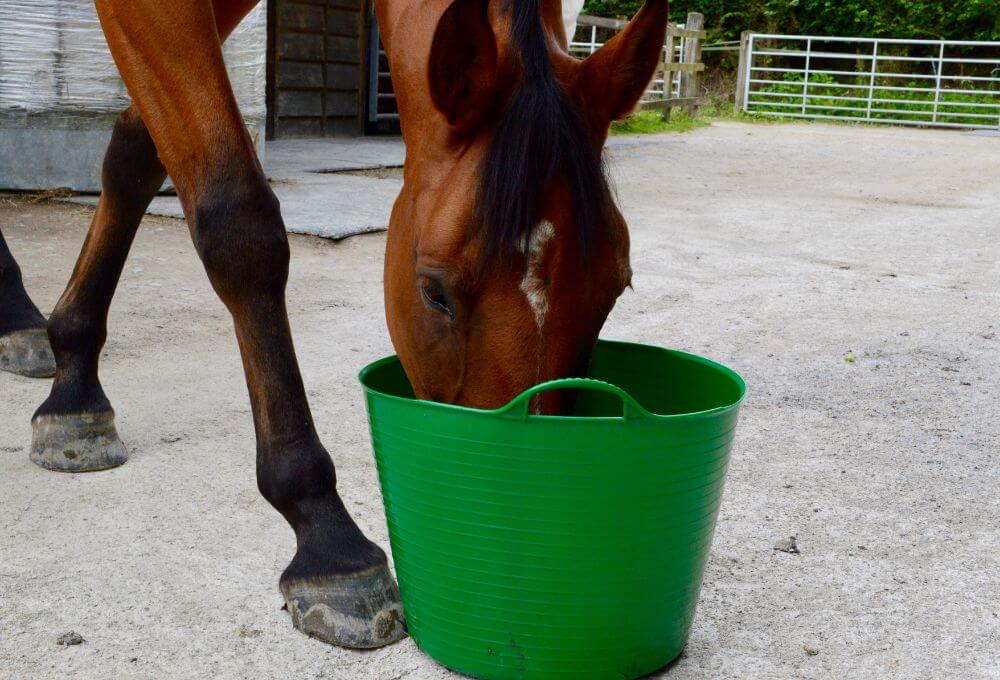
How will a bucket feed affect horse weight?
Many people overestimate the impact that a bucket feed will have on horse weight. Where you are feeding a small amount of feed to your horse, to carry minerals and vitamins, extra protein or essential omega 3 fat, then knowing how many megajoules (MJ) your bucket feed will be contributing will help you calculate and adjust the calories in the total diet.
You need to remember that grass and hay are eaten in much bigger quantities than a bucket feed. Forage will be the place where the most calories will originate but also where imbalances of nutrients start, so balancing these, by using a small bucket feed to target forage-focused nutrition, is very important for long-term health and resilience.
The following numbers will help you understand where the calories in your horse’s diet are coming from when you feed a bucket feed.
How many calories does 100 grams of micronised linseed supply to a horse?
100 grams of micronised linseed contributes 1.2 MJ to the daily diet but supplies essential omega 3 that is needed by a 500 kg horse through autumn, winter, and early spring. Once the grass is green and growing and makes up more than 50% of the diet, the grass will supply the omega 3, so this can be omitted in this situation.
An additional benefit of feeding micronised linseed is that it is an alternative protein source to grasses which make up the main portion of the diet as hay and pasture.
A variety of protein sources in the horse’s daily diet is very important to supply a range of essential amino acids which are vital for maintaining all body structures.
The more work a horse is in the more important protein from different sources is, so that an abundance of the essential amino acids, that can only be obtained from food, are supplied in the daily diet.
How many calories does 100 grams of beet pulp supply to a horse?
100 grams of unmolllassed beet pulp supplies 1.1 MJ to the daily diet. This feed is an ideal carrier for essential supplements and supplies safe, non-heating, super high fibre and slow-release energy which is unsurpassed by any other feed. This is why you will find most mixes for horses in work contain a large amount of beet pulp, if you read the label.
An additional benefit of this feed is that it contains high calcium and is an alternative protein source to grasses which will make up the main portion of the diet as hay and pasture.
How many calories does 100 grams of grass nuts supply to a horse?
100 grams of grass nuts supplies 1.1 MJ to the daily diet. This is an ideal carrier for supplements and supplies high protein, and high fibre. Grass nuts are an excellent high fibre, energy source.
How many calories does 100 grams of oats supply to a horse?
100 grams of Flaked Porridge Oats supply 1.4 MJ to the daily diet. This is an ideal carrier for supplements. Oats are tasty and a good energy source but they are high in calories and starch.
They do provide good variety as a different plant protein source and have the additional advantage of being high in phosphorous if that is needed in the diet.
Oats should not be fed to laminitis-prone horses if insulin levels are not well controlled. The best time to feed oats to a laminitis-prone horse, with well-controlled insulin levels, is immediately after work when insulin sensitivity is at its highest.
When fed with an equal portion of beet pulp, oats are not likely to be heating. With horses who are affected (very small numbers if fed with beet pulp) then if oat feeding is targeted after work, with beet pulp, they do not cause fizzy behaviour.
How many calories does 100 grams of hay nuts supply to a horse?
100 grams of hay nuts supplies 1.1 MJ to the daily diet. This is an ideal carrier for supplements and supplies high protein and high fibre. Hay nuts are an excellent high fibre, energy source.
How many calories does 100 grams of copra supply to a horse?
100 grams of copra supplies 1.5 MJ to the daily diet. This is an ideal carrier for supplements. It is a good energy source but is high in calories. It is best used with horses in moderate to heavy work, or horses needing to gain weight.
Care should be taken when choosing Copra as a feed for good doer, laminitis-prone horses as it is high in calories. It does provide good variety as a different protein source and has the additional advantage of being high in phosphorous if that is needed in the diet.
Where do the calories come from in a horse diet?
Understand the numbers to manage horse weight| Food | Amount MJ least fed | MJ most fed |
|---|---|---|
| Grass | 40.6 4 hours | 110.0 24 hours |
| Hay | 53.6 6.3 kg DM | 85.0 10 kg DM |
| Unmolassed Beet Pulp | 1.10 100 grams | 10.9 1 kg |
| Oats | 1.40 100 grams | 13.5 1 kg |
| Micronised Linseed | 1.20 100 grams | 6.00 500 grams* |
| Grass Nuts | 1.10 100 grams | 11.01 kg |
| Hay Pellets | 0.80 100 grams | 8.00 1 kg |
| Copra | 1.50100 grams | 15.0 1 kg |
* Micronised linseed should not be fed at more than 1 gram per 1 kg of body weight.
How do our numbers help horse weight management?
Now you can see just where the most calories will come from in the horse diet, and take control of which areas you can reduce. This is where the power of weight control exists.
When controlling horse weight gain in spring or summer, the place to start is with the amount of turnout time. The more turnout time, the more grass will be consumed and this is where the greatest amount of calories will come from. If you restrict turnout time then you can weigh and measure the hay and bucket feed carefully to make sure that the amount fed, in a 24-hour period, is not oversupplying calories in addition to the grass consumed.
Unsure what to feed?
Contact our team to receive expert advice on what to feed your horse.
Should I soak hay to control horse weight?
Soaking hay is a common practice to lower the simple, soluble sugar content. This will lower the carbohydrate level and thus the calorific value of the hay. However, there are a number of aspects to consider before choosing to soak hay:
- The longer the hay is soaked, the more water-soluble nutrition will be lost. The water-soluble nutrients in hay are vitamins and minerals. Those will go down the drain at the same time as the sugar and result in poor nutrition in the greatest proportion of the hay.
- The hay may already be low in simple sugar. Lowering simple sugar too far will impact energy levels, particularly when a horse is in work. When carbohydrate levels become too low a horse will often lose stamina and become lethargic.
- Hay which is soaked for more than an hour at a time will sit in a toxic soup, which is neither desirable for the environment nor the horse.
- Hay soaking for long periods of time in the same water (6 – 12 hours) has been shown to drive iron into the hay and raise the level.
The absolute best thing, if you can, is to carry out a nutritional analysis of a stable source of hay to see if soaking is even necessary. Often hay is high in ESC sugar (simple sugar) which causes insulin levels to be high. You should aim for hay that is below 10% combined ESC and starch. For very sensitive horses then a combined level of below 7% should be aimed for but usually, this can be achieved with a maximum of a three-hour soak.
Even where hay is above 10% combined then a short soak is sufficient to lower sugar enough in the majority of hay as long as the correct soaking protocol is carried out.
How should I soak horse hay?
Rinse and soak your hay in a particular way to limit the leaching of both minerals and protein. It is best to see the soaking of hay like the rinsing of clothes when washing them with detergent. In order to reduce the amount of soap in the clothes you need to use a large volume of water, agitate the clothes and change the water frequently. This is the same with lowering sugar in the hay. You should try to use one of the following systems:
How to soak horse hay in cold water
Fill a large container roughly double the size of the hay net to be soaked with cold water. Place the hay in the water, submerge and agitate for a few minutes. Leave to soak for around an hour then agitate again before discarding the water and replacing it with new. Repeat the submerging, agitating and soaking for another hour. Repeat one more time, then drain the hay. This method although time-consuming is preferable to leaving the hay sitting in the same water for many hours.
It is likely that an hour of soaking will be enough for most hays, to be sure, if your horse is actively laminitic either use hot water or get the hay analysed to check both ESC and starch levels.
How to soak horse hay with hot water
Fill a large container roughly double the size of the hay net to be soaked with hot water. Place the hay in the water, submerge and agitate for a few minutes. Leave to soak for around 15 minutes then agitate again before discarding the water and replacing it with new. Repeat the submerging, agitating and soaking for another 15 minutes. Repeat one more time, then drain the hay.
This method is preferable to leaving the hay sitting in the same water for many hours, using hot water makes the reduction of the sugar in the hay much more effective.
The use of a portable gas shower is very effective for this purpose.
Should I be worried about more than calories with my horse?
For a horse in light, moderate or heavy work, great attention must be paid to supplying enough, minerals and vitamins to power the body and create resilient health. It is also essential that sufficient protein and enough of the essential amino acids, which are contained in protein, are available.
Everyone knows not to skimp on water. Most people now know that a certain level of digestive fibre must be provided to enable the horse to keep healthy. Perhaps attention to other elements is missed, with an obsession to lower calories and cut out the ‘carbs’ to control horse weight.
Sufficient quality protein enables body structures, such as tendons, ligaments, skin, the digestive lining, and hooves to be optimally healthy. Poor doers often end up being compromised, because calories have been reduced at the expense of protein quality.
It is very common, more common than not, that owners struggling with horse weight control, focus excessively on restricting calories and pay little to no attention to the other aspects of nutrition. Nutrition is like a cake, you need more than just flour to bake a good cake and you must get the ratios of flour to butter, to sugar, to eggs right, so that the cake you bake is tasty with the right consistency.
Nutrition is just like this, you need the right amount of calories, protein, fats, carbohydrates, vitamins, minerals, fibre, water and essential fats to create a metabolically healthy horse.
Calories are the easy part of the diet to control but if you forget about the other vital parts of nutrition, then over the long term, resilience and robust health will be compromised.
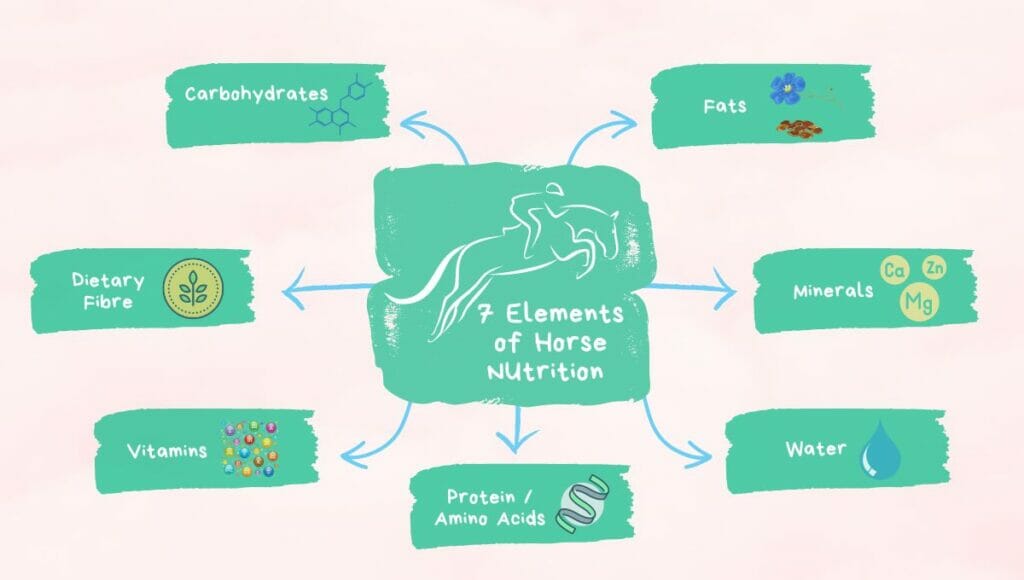
Horse weight and protein levels
According to the NRC Nutrient Requirements of Horses, a 500 kg horse will need the following minimum protein levels in the daily diet:
- Maintenance 540 grams
- Light work 630 grams
- Moderate work 720 grams
Forageplus forage analysis data shows that the average protein content of hay in the UK is around 6.5% ‘as fed’. This measures the total protein in the hay. To allow for essential amino acid availability, it is important to feed more than protein minimum levels.
It is likely that a horse on 24-hour spring and summer grazing will have adequate protein, above the minimum levels, and only lysine and methionine as limiting amino acids will need to be considered to balance the diet. Horses in heavy work are likely to need additional branch-chain amino acids as well.
Where a horse has access to 4 hours grazing then this should provide around 500 grams of protein, as long as the grazing is well managed and healthy. Much will depend upon how much hay is fed as to whether protein levels are high enough for horses in work.
All horses in light work and above should be supplemented with the essential amino acids after work, as these are likely to be short in a predominantly forage-focused diet.
Where a horse is being calorie controlled then great attention has to be paid to protein levels in the diet as protein is literally life itself. For more information on how protein can be impacted and poorly supplied when hay is restricted, this article is a must-read.
Should I feed straw to manage horse weight?
We tend to encourage people to avoid feeding straw (barley, wheat or oat) as it is nutritionally lacking. Protein, minerals, and vitamins will be poor as you are feeding the stalk after the seed has set.
It is true that horses on straw often lose weight because the indigestible fibre fraction of this feed is very high. The fact that large amounts of this feed are indigestible means it passes through the horse with little benefit. This might be fine if a horse is at maintenance, although even then if you work out the figures, the shortage of nutrients like key minerals and protein will impact long-term health.
While the owner congratulates themselves on a slimmer horse, over time the nutritional deficiencies will accumulate and ultimately niggling health issues will be the result. Our data shows that hoof abscesses and poor skin are common with horses that have been on long-term straw feeding, especially where attention to mineral and protein balancing has not been addressed through a forage-focused supplement approach. Broad-spectrum mineral balancers will not address the nutritional shortfalls in straw.
Where a horse is in moderate work then feeding straw is something, we would advise avoiding. Even if a horse is in light work it is important to calculate the numbers. If possible a nutritional analysis should be carried out to check protein and mineral levels, so that health in many different ways is not compromised.
The other issue with any straw is that it is a by-product of an industry that relies on heavy amounts of pesticides and fungicides to grow the crop. Using this to replace hay and grass which do not have these chemicals on them just makes no sense.
We have noticed, however, that people are raving about feeding straw on various Facebook Groups. We wonder if they would still rave if they sat down and did some nutritional maths. That of course will be another research project and article for the future.
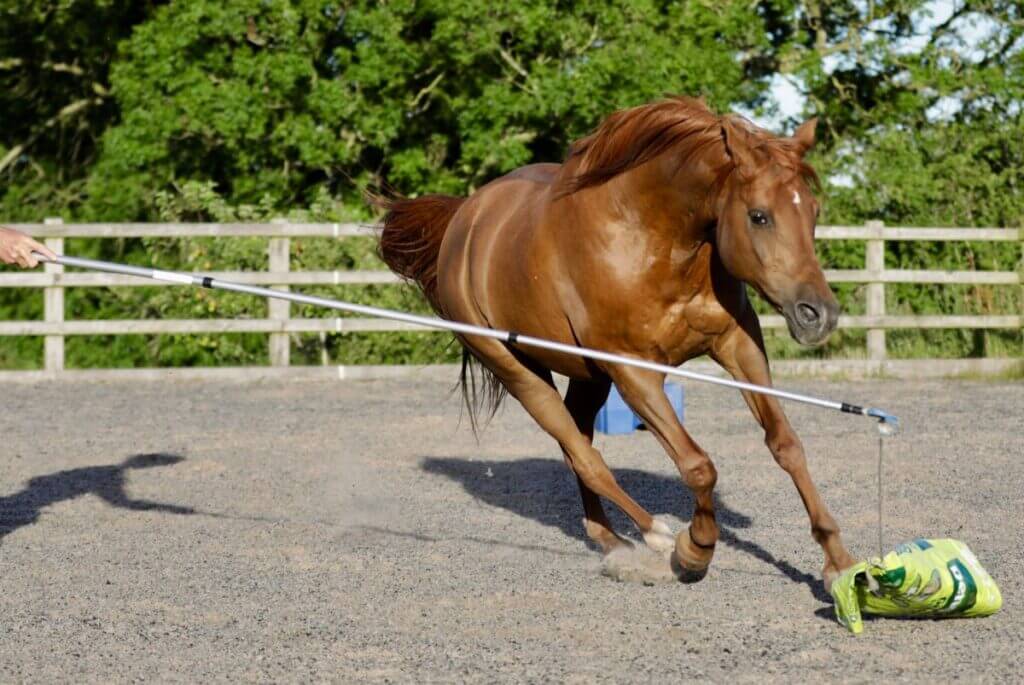
Will regular exercise help my horse lose weight?
With any horse that is capable of exercise, this is the best way to improve insulin sensitivity and affect weight loss. Weight loss is dependent upon the calorie level of the diet and the energy expended each day.
Where a horse has access to grass which is short and cropped the sugar levels can be significant. This creates high carbohydrate content, and it is this that is associated with reduced insulin sensitivity in horses. High sugar contributes to high calories with low fibre content in the diet.
As horses can consume high amounts of grazing, even when short (they are very efficient lawn mowers) then it is always worth restricting access to grass if you can. Another important consideration is that most of the sugar in grass tends to be in the bottom 7 to 10 centimetres of the plant.
Where you are unable to reduce access to grazing, then using exercise to improve metabolic function and ‘use up’ the excess calories from spring and summer grass is the best course of action. Turnout alone (even on a track system) will not be enough to affect insulin sensitivity and counteract the high calories in spring and summer grass.
Horse exercise to reduce weight needs to be much more than walking. It should consist of activity which raises the horse’s heart rate and is long enough and vigorous enough that the horse either just starts to sweat or is sweating when the exercise stops. Usually, this means both trotting and cantering.
This work does not have to be ridden, it could be free or on the lunge, but it must be done 5 to 6 days a week with consistency. 10 to 15 minutes of exercise like this every day will make a big difference to a horse within as little time as 15 days. Uphill work or ponying from another horse is also worth considering. Whatever the exercise is, it needs to significantly increase heart rate and oxygen consumption to prompt metabolic adaptations.
What Forageplus suggests to control horse weight
- Pay great attention to every aspect of the components of horse nutrition, not just calories. If you get enough protein into your horse’s daily diet this satiates appetite. Protein will make a horse feel full and not feel the need to eat as much. This is the same for humans.
- If you are struggling to control horse weight, turn out for a strict 4 hours only or even less. Decide, based on the bucket feed figures above, how much bucket feed you wish to feed, then feed the right amount of hay to adjust for calorie (MJ) intake.
- It is best to weigh the hay and know, rather than guess, how much a horse is eating. This means you control intake because you understand grass and hay are the places where the most calories come from as a proportion of the total diet. Use a fish scale or electronic luggage scale to weigh hay nets.
- Never skimp on feeding minerals and vitamins which are matched to a common profile of forage. This means adding a forage-focused horse feed balancer to a small bucket feed each day. After more than ten years of carrying out thousands of analyses of grass, hay and haylage we know that all forage is imbalanced and a forage-focused balancer is always needed for the best, long-term, horse health.
The harder your horse works the more protein, vitamins and minerals they will need to fuel health. Calories are also important so that muscle mass is maintained and developed.
As a guide feeding this as a bucket feed will take the MJ per day to 97.6 which is perfect for a 500 kg horse in moderate work.
- 100 grams of Grass Pellets
- 100 grams Speedi-Beet (dry weight – or unmolassed sugar beet)
- 100 grams Micronised Linseed
For energy feed a small after-work bucket feed of 100 grams of flaked porridge oats and 100 grams of beet pulp. This will supply 2.4 MJ to the total diet and 23 grams of protein but will provide a slow-release energy source (beet pulp) and a fast-release energy source (oats) at the time when the body most needs it.
Oats fed after a work session are non-heating and the best way to store sensible energy for the next work session. In addition, include 75 grams of Essential Amino Acids and any salt for sweat loss. The essential amino acids are vital to boost these parts of protein which can only be obtained from the daily diet and are often short in a forage-based diet.
A good guide for salt is to feed 25 grams per hour of total time sweating. If you see your horse licking their salt block at this level, then double it. This should be fed after work.
Protein will probably need to be boosted on a daily level too so feeding 100 grams of Topline Plus or Pea Protein in the bucket feed will also help a horse in moderate work maintain body structures which are placed under stress.
How to get more help
If all the numbers are making your head spin, or you have a horse less than or greater than 500 kg in body weight, then our experts are only an email away with more expert help and advice.

